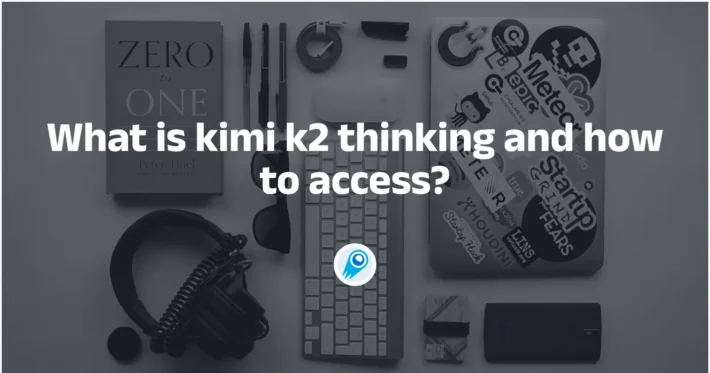How to Use Kimi K2 for free? 3 Ways

Kimi K2 has rapidly emerged as one of the most talked‑about open‑weight Mixture‑of‑Experts (MoE) language models of 2025, offering researchers and developers unprecedented access to a trillion‑parameter architecture at no cost. In this article, we’ll explore what makes Kimi K2 special, walk through multiple free access methods, highlight the latest developments and debates in the community, and show how you can integrate Kimi K2 into your own workflows—all without spending a dime.
What is Kimi K2 and why is it significant?
Kimi K2 is a state‑of‑the‑art MoE model developed by Moonshot AI, featuring 1 trillion total parameters with 32 billion active experts per forward pass. Trained on 15.5 trillion tokens using the MuonClip optimizer, it excels at advanced reasoning, code synthesis, and agentic tasks—capabilities that were once the exclusive domain of proprietary systems. Because its weights are fully open and downloadable, it democratizes frontier AI research, enabling anyone with sufficient hardware to fine‑tune, customize, or extend the model to novel applications .
Agentic Intelligence
Kimi-K2’s “agentic” design means it can autonomously plan and execute multi‑step tasks—pulling in external data, invoking tools, and maintaining context over long interactions. This makes it ideal for building AI assistants that go beyond simple chatbots.
Performance Highlights
Independent evaluations have shown Kimi-K2 outperforming several leading open‑source and proprietary models in key benchmarks:
- Coding and Reasoning Benchmarks: In LiveCodeBench, Kimi K2 achieved a 53.7% accuracy, surpassing both DeepSeek‑V3 (46.9%) and GPT‑4.1 (44.7%).
- Mathematical Reasoning: On the MATH‑500 dataset, Kimi K2 scored 97.4%, compared to GPT‑4.1’s 92.4%.
- General Agent Tasks: On the SWE‑bench Verified suite, Kimi K2 reached 65.8% accuracy, outperforming most open‑source alternatives .
How can you access Kimi K2 for free via the official web interface?
Moonshot AI provides an official chat UI at https://kimi.com, where anyone can log in and select “Kimi‑K2” from the model dropdown—no payment details or waiting lists required. While the UI is predominantly in Chinese, leveraging your browser’s built‑in translation tools renders it entirely navigable for English speakers .
Official Chat UI
- Navigate to https://kimi.com and create or log into your account.
- Use Google Translate (or equivalent) to translate the interface.
- Choose “Kimi‑K2” from the model selection menu.
- Enter prompts as you would in any chat interface.
Usage Characteristics
- Unlimited queries: Unlike many free demos, there are no token quotas or time restrictions.
- Search‑like behavior: The interface emphasizes agentic retrieval and reasoning over conversational flair.
On the official Moonshot AI site, you’ll find two main offerings for free users:
- Kimi‑K2‑Base: A base model optimized for research, with full access to weights, APIs, and community support channels.
- Kimi‑K2‑Instruct: A fine‑tuned version tailored for interactive chat and agentic tasks, including built‑in tool‑calling capabilities.
Both versions can be accessed from your dashboard immediately after signup, with usage quotas that reset monthly .
Where else can you try Kimi K2 for free online?
Beyond the official site, multiple community‑driven demos allow you to experiment with Kimi K2 in different contexts.
Hugging Face Spaces Demo
For those who prefer a more developer‑centric environment, Moonshot hosts a free demo on Hugging Face Spaces. The “Kimi K2 Instruct” space lets users experiment with prompts and receive responses directly in the browser. To use this demo:
- Navigate to the Kimi K2 Instruct Space on Hugging Face.
- Log in or create a free Hugging Face account.
- Select the “Kimi K2” model from the dropdown.
- Submit prompts to see immediate outputs without any payment .
Open‑Weight Model Download
As an open‑weight model, the full parameter set for Kimi K2 is publicly hosted on GitHub. Researchers and organizations can:
- Clone the GitHub repository to obtain the trained weights.
- Integrate Kimi K2 into local inference pipelines using PyTorch or TensorFlow.
This option removes any dependency on external APIs, enabling unlimited free usage—subject only to the user’s own compute resources.
Researcher API Access
Moonshot AI provides a low‑cost API endpoint for Kimi K2, with a tier that effectively offers free access for academic and non‑commercial research. Applicants fill out a short form attesting to their research purpose. Upon approval, the API key grants a generous quota suitable for evaluations, prototypes, and small‑scale experiments.
How can you run Kimi K2 locally without cost?
For those with access to high‑end GPUs, Moonshot AI has open‑sourced the full Kimi K2 weights on GitHub and Hugging Face, allowing researchers to self‑host the model.
Downloading the Weights
- Retrieve the 1 trillion‑parameter checkpoint from the official repository at https://github.com/MoonshotAI/Kimi-K2.
- Ensure you have at least 8 x A100 GPUs (or equivalent) to host the full model.
Inference Engines
Deploy Kimi K2 using optimized runtimes such as vLLM, KTransformers, or TensorRT‑LLM. These engines support expert‑routing strategies to activate only the necessary subsets of parameters per request, minimizing hardware overhead.
What Are the Limitations of Free Access?
While Moonshot’s free offerings are generous, several practical constraints apply.
Rate Limits
- App and Browser Interface: Sessions may be limited to 100 requests per day to ensure fair use.
- Hugging Face Demo: May throttle requests during peak times, leading to slower response or temporary suspension.
- Researcher API: Initial quotas typically cover up to 100K tokens per month. Additional tokens require upgrading to a paid plan.
Feature Limitations
- Tool Integration: Advanced chaining and tool calls (e.g., code execution, web retrieval) may be restricted to paid tiers.
- Fine‑Tuning: Full fine‑tuning capabilities are reserved for enterprise customers; free users can only use the base and instruction‑tuned checkpoints.
How can I use Kimi K2 via third‑party APIs?
CometAPI and similar API marketplaces expose Kimi K2 endpoints with free usage tiers that let you embed the model in bots, apps, or CI pipelines.
CometAPI API
- Create a free account on CometAPI and create API key.
- Locate the “Kimi K2 API” provider page and get model call.
- Copy your API key and endpoint URL.
- Issue HTTP POST requests in JSON format from your code.
import requests
API_URL = "https://api.cometapi.com/v1/chat/completions"
headers = {"Authorization": f"Bearer {YOUR_TOKEN}"}
payload = {
"model": "kimi-k2-0711-preview",
"messages": [{"role": "user", "content": "Write a Python function to reverse a string."}],
"max_tokens": 200
}
response = requests.post(API_URL, headers=headers, json=payload)
print(response.json()["choices"][0]["message"]["content"])This works identically across providers—just swap API_URL and YOUR_TOKEN.
Pricing for CometAPI API calls is highly competitive—approximately \$0.11 per million input tokens and \$1.99 per million output tokens—compared to \$15/\$75 for Anthropic’s Claude Opus 4. This cost‑efficiency makes K2 suitable for large‑scale deployments without breaking the bank.
What best practices ensure optimal Kimi K2 performance?
To maximize K2’s capabilities while managing resource consumption, adopt targeted prompts, batch requests, and adaptive routing.
Prompt engineering
Craft concise, context‑rich prompts that specify desired formatting, style, and constraints. For example:
“You are a Python expert. Write a unit test suite for the following function, ensuring coverage of edge cases.”
This level of detail reduces model “hallucinations” and improves output relevance.
Managing computation
Leverage the MoE architecture by batching related inferences to minimize expert switching overhead. When using the API, group prompts under a single connection and adjust temperature and max_tokens to balance creativity with cost. For on‑premises deployments, monitor GPU memory usage, and offload non‑critical components (e.g., tokenization) to CPU threads to free up VRAM.
Kimi K2’s MoE architecture offers flexibility:
- Base vs. Instruct: For content generation where safety is less critical, use the Base variant to benefit from higher rate limits. Switch to Instruct only when strict alignment or tool use is necessary.
- Self‑Hosted Adapters: In self‑hosted setups, you can load smaller expert subsets or apply LoRA adapters to reduce memory footprint while retaining performance for specific tasks .
Conclusion
Kimi K2 represents a watershed moment in open AI: a trillion‑parameter, agentic model freely available to everyone. Between the official web UI, community demos on Hugging Face and DeepInfra, local self‑hosting, and free API endpoints, there’s no shortage of ways to experiment with Kimi K2 without touching your wallet. Coupled with the latest technical report, spirited debates against emerging challengers like Qwen, and powerful integrations through Apidog MCP Server, now is the perfect time to explore what Kimi K2 can do for your projects—at zero cost.


